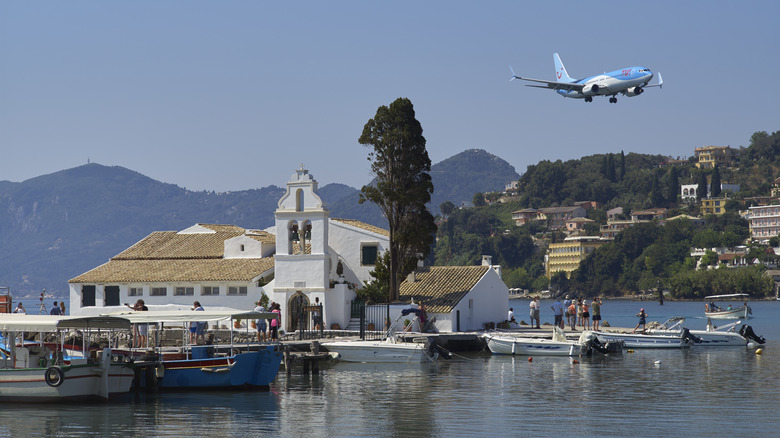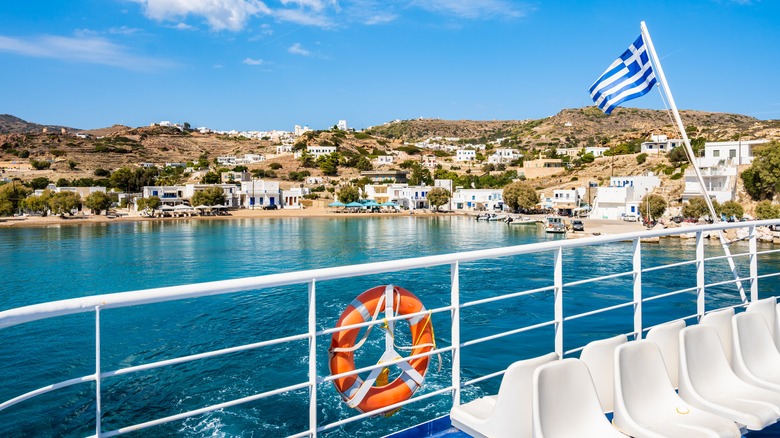The Annoying Reason To Avoid Island Hopping Around Greece By Plane
Greece has over 6,000 islands, though only around 227 are inhabited. Each island has its own unique character, from the iconic white-washed buildings of Santorini to the wild party vibe of Mykonos and the untouched beauty of smaller, lesser-known islands like Folegrandos and Ithaca. Island hopping allows travelers to experience the diverse landscapes, cuisines, histories, and cultures of these islands in one convenient and efficient trip. This way of travel is a popular choice for people on a time crunch, eager to experience as much as possible.
On paper, flying between these islands seems like the perfect way to maximize your time, avoiding long ferry rides and reaching your next destination in minutes. After all, picking between a 45-minute flight and a four-hour ferry from Athens to Mykonos seems like a no-brainer. However, the reality of island hopping by plane is often far from ideal, and there are a few annoying reasons why jet-setting can turn your dreamy vacation into a logistical nightmare.
Most flights throughout the Greek island archipelago require travelers to go back to the International Airport of Athens (ATH) — the largest airport in Greece and a main gateway for domestic flights to the islands — so that they can take the next flight to the next island, essentially adding a completely unnecessary detour. Flights from one island to another are limited — practically non-existent — because the airports are not connected via direct flights. What's more, not all islands are accessible by plane, and not all islands have domestic or international airports.
Logistics of plane-hopping the Greek islands
Another frustrating aspect of flying is the sheer hassle of navigating the islands' airports, many of which are small, with limited amenities and resources. Check-in lines can be long and slow-moving, and waiting areas often lack basic comforts such as air conditioning or sufficient seating — especially during the summer when Greece and its more popular islands suffer from overtourism. Plus, many airports are located away from the main tourist areas, requiring lengthy transfers by taxi or bus.
What might have seemed like a quick hippity-hop to the next island can easily turn into hours of travel time when you factor in the journey to and from the airport, security checks, waiting times, and potential delays. Besides, flight costs can add up, with hidden fees, checked baggage fees, seat selection charges, and airport taxes hiking up the cost of your idyllic Greek vacay. Budget airlines also have notoriously restrictive baggage policies; exceeding the weight limit can result in hefty fees.
Despite the limitations of airports and flight routes between the Greek islands, some travel itineraries would actually benefit from flying instead of ferrying. Let's say you are only going to the islands of Paros and Naxos on a one-week trip; the most efficient route would be to fly from Athens to Paros, take a ferry from Paros to Naxos, and then fly from Naxos to Athens to catch your plane back to your home country. However, if you plan to explore more islands, say three, four, or even more — especially remote ones that are off the beaten path — then jet-setting between them is not the way to go.
Why ferries might be the way to travel
Although it takes longer, island hopping by ferry is the best mode of transport for more complex itineraries. Ferries are well-connected, properly scheduled, and often allow you to bring extra luggage without extra charges. Plus, they are more affordable than flights — a must for anyone visiting Greece on a budget. Ferries also offer a scenic and leisurely way to travel between the islands, allowing you to enjoy the breathtaking views of the Aegean and Ionian Seas. Sailing through Mediterranean waters with the sun shining and the wind in your hair is a quintessential element of the island-hopping experience.
Flights offer none of this, reducing your journey to a sterile, enclosed experience devoid of everything that makes Greece so special. Furthermore, flying has a larger environmental footprint. Greece, like many other popular tourist destinations, is grappling with the impact of mass tourism on its environment. Air travel is one of the biggest contributors to carbon emissions, while ferries, particularly those that run on newer, more sustainable technologies, have a lower environmental impact.
To map out your trips, find schedules, and book your tickets, use Ferry Hopper. There's even an "Island Hopping" planner on the site. Here's another fantastic option: Eurail offers a Greek island-hopping pass. The Greek islands can be divided into six clusters: Cyclades, Sporades, Ionian, Dodecanese, Saronic, and North Aegean islands. To figure out the perfect itinerary — and decide whether to fly or ferry (or a bit of both) — you should choose a single cluster (or two) and travel within it. This will maximize your efficiency and allow you to experience as many beautiful Greek islands as possible.


